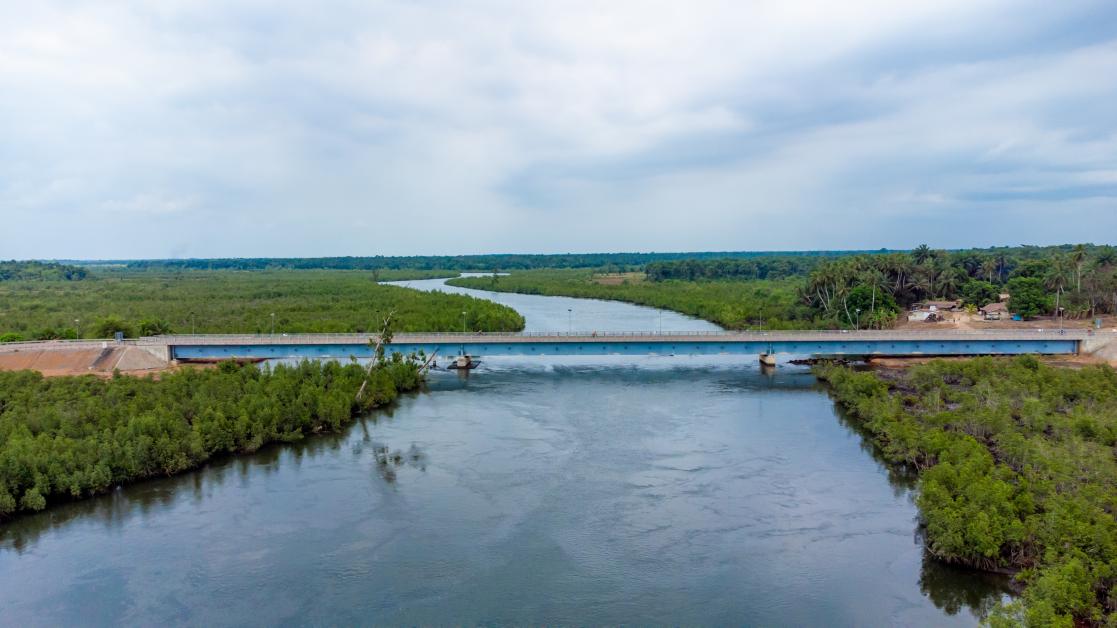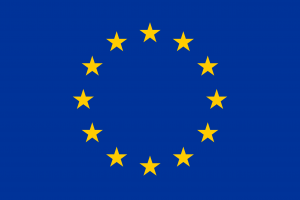Enhancing connectivity: EU roads and bridges programme in Sierra Leone

This programme includes several major projects, each with specific timelines and investments:
- Moyamba junction road and bridges (2013 – 2024, EUR 48 million): This project transformed 32.8 km of road infrastructure and built four major bridges—Magbele, Mabang, Gbangbama, and Moyamba. These upgrades have effectively connected Moyamba town to the Masiaka-Bo highway, making it easier for goods and people to move between communities.
- Bandajuma-Liberian border road and bridges (2013 – 2023, EUR 105.2 million): This component of the project has developed a 98 km stretch of all-weather road from Bandajuma to the Liberian border. It includes the construction of seven bridges including three major bridges over the Sewa, Waanje, and Moa rivers, replacing unreliable ferry crossings. This improvement has made road travel between Guinea and Liberia faster and safer.
- Rehabilitation and maintenance of the Makeni–Kabala road and widening of 7 bridges along the Masiaka–Bo highway (2012 – 2015, EUR 11.9 million): 118 km of road upgraded and seven bridges widened across Bombali, Koinadugu, Bo, and Tonkolili districts.
- Urban road rehabilitation: Rue De La Paix, Lumley Beach Road, and Gloucester Junction (2012 – 2015, EUR 11.3 million): 11.2 km of road rehabilitated, with added risk-mitigation works in slum areas like Moyiba, Madongo, and Tengbeh Town in Freetown.
- A West African Response to Ebola (AWARE) (2015 – 2018, EUR 5.1 million): 175 km of roadwork improved access in Bombali, Koinadugu, and Tonkolili during the Ebola outbreak.
- Feeder road rehabilitation in Kenema, Port Loko, Kambia, and Pujehun (2008 – 2010, EUR 6.3 million): 650 km of rural roads improved
- Rehabilitation of the Masiaka to Bo Highway (2006 – 2010, EUR 38.4 million): A key 164 km corridor improved across Port Loko, Tonkolili, Moyamba, and Bo.
-
Freetown–Conakry Highway Phase II (2009 – 2013, EUR 25.3 million): 85 km of road upgraded—76 km in Sierra Leone and 9 km in Guinea—strengthening cross-border connectivity and regional integration in the Mano River sub region.
Image Copyright
CopyrightEU in Sierra Leone
Key achievements:
• Over 355 km of roads built or rehabilitated across the country, strengthening national and regional connectivity.
• Major roads like the Masiaka–Bo highway, Makeni–Kabala road, and Freetown–Conakry highway improved, boosting safe travel and economic activity.
• 14 major bridges constructed or widened, including the landmark Magbele (PC Alikali Modu III Bridge) and Mabang bridges (Koblo Gulama Bridge).
• Urban road rehabilitated in Freetown reduced congestion and improved access in key areas like Lumley, Moyiba, and Madongo town.
• Safer access to education, healthcare, and markets for rural and urban communities across Bombali, Koinadugu, Kenema, Port Loko, Pujehun, Kambia, Bo, and Western Urban districts.
• Slum upgrade works, such as pedestrian stairs, retaining walls, and footbridges, improved mobility and resilience in vulnerable communities.
• Ferry crossings over key rivers replaced with modern bridges, enabling year-round travel between Sierra Leone, Liberia, and Guinea.
• Improved logistics and access during the Ebola crisis through road works under the AWARE project.
- Upgraded roads: The construction of 32.8 km of Class A all-weather roads at the Moyamba junction to Moyamaba has greatly improved local transport and access to remote areas.
- New bridges: Four major bridges—Magbele (Alikali Modu Bridge), Mabang (Koblo Gulama Bridge), Gbangbama, and Moa River Bridge—are now operational, enabling smooth travel across the regions.
- Seamless regional travel: The new Bandajuma-Liberian border road has transformed a once difficult 98 km journey into a reliable and efficient route, supporting cross-border trade and movement.
- Eliminated ferry crossings: The new bridges over the Sewa, Waanje, and Moa rivers have replaced local ferry crossings, ensuring safe and continuous road travel between Guinea and Liberia.
- Boosted local development: Improved roads and bridges have connected communities to markets, healthcare, and education, supporting the growth and prosperity of the Sierra Leonean people.
The EU Roads and Bridges Programme has gone beyond upgrading infrastructure. The EU has partnered with Sierra Leone for over 20 years to build roads and bridges—not just to connect places, but to connect people. These investments help Sierra Leoneans improve their livelihoods through better access to markets, cross-border travels and trade, and essential services like schools and hospitals.

EU in Sierra Leone
From Freetown to the borders with Liberia and Guinea, the goal is simple: make travel easier, safer, and faster. This translates into better mobility and greater opportunities for the people of Sierra Leone. From a regional perspective, the Trans–West African Coastal Highway, part of the Praia-Dakar-Abidjan corridor and forming part of the Global Gateway —largely funded by the EU—has enhanced regional integration, easing cross-border movement and boosting trade and economic activities.






